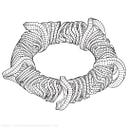The Evolution and Significance of America’s Aerial Tank Destroyer Units

In the annals of military history, the integration of aviation into ground forces has always been a topic of fascination and debate. The U.S. Army’s exploration into this realm, particularly in the 1960s and 1970s, offers a compelling narrative of innovation, adaptation, and the relentless pursuit of battlefield superiority.
In the early 1960s, the U.S. Army was presented with the Howze Board’s ambitious report, which envisioned a radical transformation of the Army’s force structure. The report proposed the creation of five Air Assault divisions, each boasting over 450 aircraft. This was a bold vision, especially considering that the Army would eventually maintain only one such division for the majority of its history. But the Howze Board’s recommendations didn’t stop there. They also envisaged the establishment of three air Cavalry combat brigades, designed to be agile, lethal, and capable of delivering devastating firepower from the air.
The conceptual foundation of these brigades was intriguing. They were envisioned as aerial fighting units, adept at maneuvering in the skies, catching the enemy off-guard, and unleashing a barrage of firepower from rotary-wing light attack helicopters. These brigades would also deploy air-delivered infantry and tank-killer teams, with a primary focus on neutralizing enemy armor and mechanized forces. The secondary emphasis would be on softer targets, equipped with anti-personnel weapons. With their inherent reconnaissance capabilities, these brigades could also undertake reconnaissance and specific defensive security missions.
Drawing parallels with the U.S. tank destroyer units of World War II offers an insightful perspective. Just as observation helicopters identified enemies for attack helicopters, tank destroyer units had organic scouts, like jeeps and armored cars, to perform similar roles. Both units prized superior mobility, and the concept of “pursuit by fire” was a shared tactical approach. However, the aerial brigades had a broader scope, given their reconnaissance and security roles in support of higher echelons.
The 1970s witnessed a significant shift in the Army’s perception of attack helicopters. Previously seen primarily as tools for delivering rocket fire in support of ground troops, they began to be viewed as units capable of independent maneuvering and delivering anti-tank fire to achieve broader strategic objectives. This evolution was evident in the Vietnam War, where the primary role of attack helicopters was to provide security for air assaults. Post-Vietnam, the focus shifted to the enemy, with attack helicopters envisioned as decisive game-changers on the battlefield.
However, the journey from concept to realization was not immediate. The air Cavalry combat concept underwent rigorous testing as part of the First Cavalry’s triple capability experiment in the early 1970s. While the broader division concept didn’t gain traction, the air Cavalry combat brigade emerged successful, eventually evolving into the independent 6th Cavalry Brigade.
The structure of this brigade was comprehensive. It comprised a headquarters, two attack helicopter battalions, an air Cavalry squadron, and support units. The air Cavalry squadron, envisioned as the “hunter” in the hunter-killer paradigm, was equipped with a mix of attack and observation helicopters. In contrast, the attack helicopter battalions, the “killers,” were armed with the latest attack helicopters, prioritizing them over the air Cavalry squadrons.
The tactical employment of these units was intricate. The air Cavalry squadron’s primary mission was reconnaissance and security for the core commander, while the attack helicopter battalions focused on reconnaissance and target acquisition for their paired attack helicopters. The synergy between scouts and attack helicopters was crucial, allowing for swift target identification and destruction.
